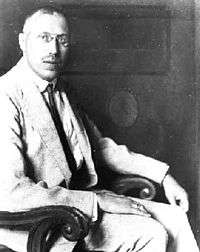Hans Hahn (mathematician)
Hans Hahn (German: [haːn]; 27 September 1879 – 24 July 1934) was an Austrian mathematician who made contributions to functional analysis, topology, set theory, the calculus of variations, real analysis, and order theory.
Hans Hahn | |
|---|---|
 Hans Hahn (about 1905) | |
| Born | 27 September 1879 |
| Died | 24 July 1934 (aged 54) |
| Nationality | Austrian |
| Alma mater | University of Vienna |
| Known for | |
| Scientific career | |
| Fields | |
| Institutions |
|
| Doctoral advisor | Gustav Ritter von Escherich |
| Doctoral students | |
| Other notable students | Karl Popper |
Biography
Born in Vienna as the son of a higher government official of the k.k. Telegraphen-Korrespondenz-Bureau (since 1946 named "Austria Presse Agentur"), in 1898 Hahn became a student at the Universität Wien starting with a study of law. In 1899 he switched over to mathematics and spent some time at the universities of Strasbourg, Munich and Göttingen. In 1902 he took his Ph.D. in Vienna, on the subject "Zur Theorie der zweiten Variation einfacher Integrale". He was a student of Gustav von Escherich.
He was appointed to the teaching staff (Habilitation) in Vienna in 1905. After 1905/1906 as a stand-in for Otto Stolz at Innsbruck and some further years as a Privatdozent in Vienna, he was nominated in 1909 Professor extraordinarius in Czernowitz, at that time a town within the empire of Austria. After joining the Austrian army in 1915, he was badly wounded in 1916 and became again Professor extraordinarius, now in Bonn. In 1917 he was nominated a regular Professor there and in 1921 he returned to Vienna with this title, where he stayed until his rather early death in 1934 at the age of 54, following cancer surgery.[1] He had married Eleonore ("Lilly") Minor in 1909 and they had a daughter, Nora (born 1910).
He was also interested in philosophy, and was part of a discussion group concerning Mach's positivism with Otto Neurath and Phillip Frank prior to the First World War. In 1922, he helped arrange Moritz Schlick's entry into the group, which led to the founding of the Vienna Circle, the group that was at the center of logical positivist thought in the 1920s. His most famous student was Kurt Gödel, whose Ph.D. thesis was completed in 1929. Within the Vienna Circle, Hahn was also known (and controversial) for using his mathematical and philosophical work to study psychic phenomena; according to Karl Menger he sometimes openly advocated further research into extrasensory perception while lecturing.[2]
Hahn's contributions to mathematics include the Hahn–Banach theorem and (independently of Banach and Steinhaus) the uniform boundedness principle. Other theorems include:
- the Hahn decomposition theorem;
- the Hahn embedding theorem;
- the Hahn–Kolmogorov theorem;
- the Hahn–Mazurkiewicz theorem;
- the Vitali–Hahn–Saks theorem.
Hahn authored the book (Hahn 1921): according to Arthur Rosenthal,[3] "... (it) formed a great advance in the Theory of Real functions and had a great influence on the further development of this theory". He was also a co-author of the book Set Functions,[4] published in 1948 by Arthur Rosenthal, fourteen years after his death in Vienna in 1934.
In 1921 he received the Richard Lieben Prize. In 1926 he was the president of the German Mathematical Society. In 1928 he was an Invited Speaker at the International Congress of Mathematicians in Bologna.[5]
Publications
All his mathematical and philosophical works, except all books and all but one of his book reviews, are published in the three volumes (Hahn 1995), (Hahn 1996) and (Hahn 1997) of his "Collected papers".[6]
- Hahn, Hans (1921), Theorie der reellen Funktionen. Erster Band (in German), Berlin–Heidelberg: Springer-Verlag, pp. VII+600, doi:10.1007/978-3-642-52624-4, hdl:2027/pst.000003378601, ISBN 978-3-642-52570-4, JFM 48.0261.09[7] (freely available at the Internet Archive).
- Hahn, Hans (1932), Reelle Funktionen. Tl. 1. Punktfunktionen, Mathematik und ihre Anwendungen in Monographien und Lehrbüchern (in German), Band 13, Leipzig: Akademische Verlagsgesellschaft, pp. XII+415, JFM 58.0242.05, Zbl 0005.38903[8]
- Hahn, Hans; Rosenthal, Arthur (1948), Set Functions, Albuquerque, N. M.: The University of New Mexico Press, pp. ix+324, MR 0024504, Zbl 0033.05301[9]
- Hahn, Hans (1995), Gesammelte Abhandlungen/Collected works. Band 1/Vol. 1 (in German), Wien: Springer-Verlag, pp. xii+511, ISBN 978-3-211-82682-9, MR 1361405, Zbl 0859.01030
- Hahn, Hans (1996), Gesammelte Abhandlungen/Collected works. Band 2/Vol. 2 (in German), Wien: Springer-Verlag, pp. xiii+545, ISBN 978-3-211-82750-5, MR 1394443, Zbl 0847.01033.
- Hahn, Hans (1997), Gesammelte Abhandlungen/Collected works. Band 3/Vol. 3 (in German), Wien: Springer-Verlag, pp. xiii+581, ISBN 978-3-211-82781-9, MR 1452103, Zbl 0881.01046.
Notes
- Hans, Hahn (Mar 7, 2013). Hans Hahn Collected Works Volume 1. Springer Verlag. p. 28. ISBN 9783709166017.
- Josephson-Storm, Jason (2017). The Myth of Disenchantment: Magic, Modernity, and the Birth of the Human Sciences. Chicago: University of Chicago Press. p. 260-3. ISBN 0-226-40336-X.
- See Arthur Rosenthal preface to the book (Hahn & Rosenthal 1948, p. v).
- See (Hahn & Rosenthal 1948).
- Hahn, H. "Über stetige Streckenbilder". In Atti del Congresso internazionale dei Matematici, Bologna, 1928, vol. 2, pp. 217–220; reprinted in: Hahn H. (1995) "Über stetige Streckenbilder". In: Schmetterer L., Sigmund K. (eds) Hans Hahn Gesammelte Abhandlungen Band 1/Hans Hahn Collected Works Volume 1, pp. 435–438. Springer, Vienna doi:10.1007/978-3-7091-6601-7_16
- According to S.Gottwald in his review Zbl 0859.01030 of the first volume (Hahn 1995).
- Jackson, Dunham (1922). "Review: Theorie der reellen Funktionen, by Hans Hahn" (PDF). Bull. Amer. Math. Soc. 28 (8): 408–411. doi:10.1090/s0002-9904-1922-03604-x.
- Whyburn, G. T. (1933). "Review: Reelle Funktionen. Erste Teil: Punktfunktionen, by Hans Hahn" (PDF). Bull. Amer. Math. Soc. 39 (9): 655. doi:10.1090/s0002-9904-1933-05702-6.
- Federer, Herbert (1949). "Review: Set Functions, by Hans Hahn and Arthur Rosenthal" (PDF). Bull. Amer. Math. Soc. 55 (3): 316–317. doi:10.1090/s0002-9904-1949-09195-4.
External links
- O'Connor, John J.; Robertson, Edmund F., "Hans Hahn (mathematician)", MacTutor History of Mathematics archive, University of St Andrews.
- Josef Lense (1966), "Hahn, Hans, Mathematiker", Neue Deutsche Biographie (NDB) (in German), 7, Berlin: Duncker & Humblot, pp. 506–506